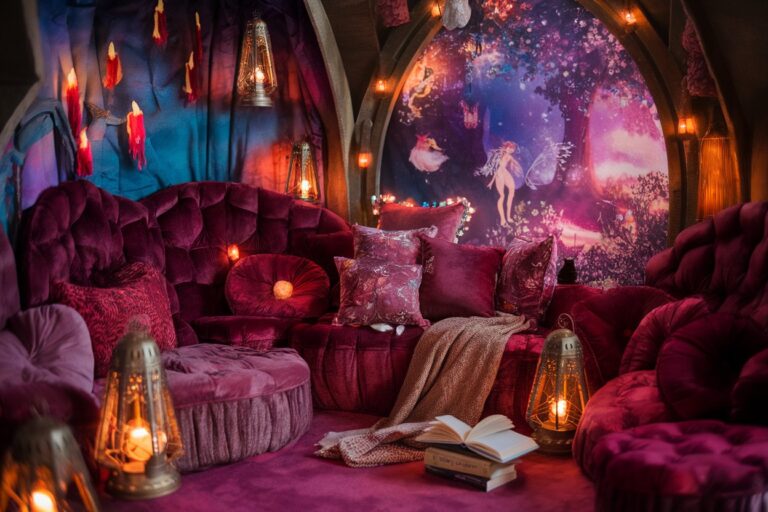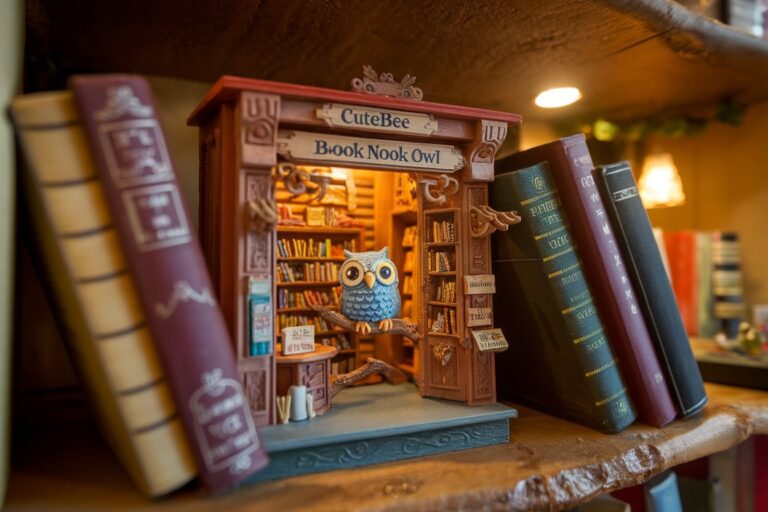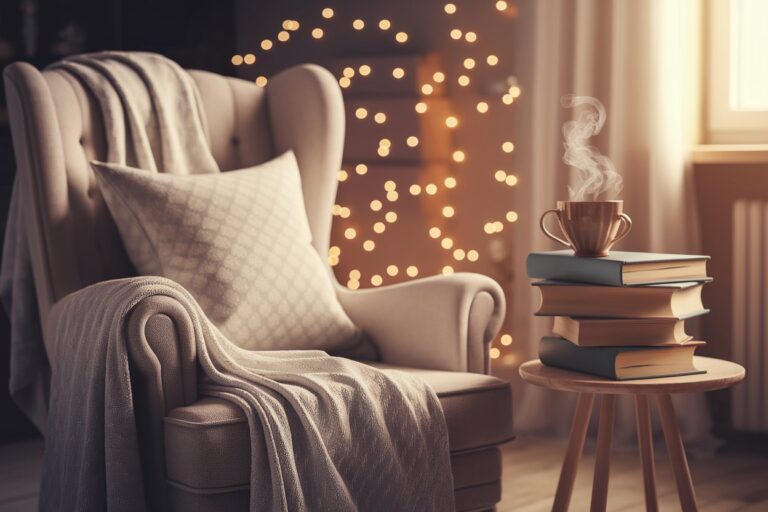Transform your home with a cozy reading nook for journaling! Discover essential elements, creative ideas, and expert tips to create your perfect book lover’s sanctuary.
Discover how to create your perfect sanctuary for reading and journaling with these creative ideas and expert tips.
Have you ever dreamed of having that perfect little corner in your home where you can escape into the pages of a good book and record your thoughts in your journal? As an avid reader and journaler, I’ve discovered that having a dedicated reading nook not only enhances my reading experience but also deepens my connection with the books I read through journaling.
In this guide, I’ll walk you through everything you need to know about creating your own cozy reading nook for journaling—a personal sanctuary that combines comfort, functionality, and style. Whether you have a spacious home or a tiny apartment, there’s always room for a special spot dedicated to your literary adventures.
Table of Contents
- What is a Journaling Reading Nook, and How Can I Create One?
- How Do I Choose the Perfect Spot for a Reading Nook in My Home?
- What Are the Essential Elements of a Cozy Reading Nook?
- How Can I Incorporate Journaling Into My Reading Routine?
- What Types of Seating Are Best for a Reading Nook?
- How Do I Add Storage for Books and Journals in My Reading Nook?
- What Lighting Options Are Ideal for Reading and Journaling?
- Can I Create a Reading Nook Outdoors?
- How Do I Style My Reading Nook with Textiles and Colors?
- What Are Some Creative Ways to Repurpose Small Spaces into Reading Nooks?
- How Can I Make My Reading Nook Feel More Intimate and Private?
- What Are the Benefits of Having a Dedicated Space for Reading and Journaling?
- How Do I Incorporate Plants Into My Reading Nook Design?
- What Are Some Popular Reading Nook Trends for 2024?
- How Can I Use a Closet or Loft as a Reading Nook?
- What Are the Best Types of Journals for a Reading Nook?
- How Do I Keep My Reading Nook Organized and Clutter-Free?
- Can I Use a Reading Nook for Other Activities Besides Reading and Journaling?
- How Do I Create a Themed Reading Nook?
- What Are Some DIY Projects for Building a Reading Nook?
- The Joy of Having Your Own Reading and Journaling Sanctuary
What is a Journaling Reading Nook, and How Can I Create One?
A journaling reading nook is a dedicated space in your home designed specifically for reading books and writing in your journal. It combines comfortable seating, good lighting, storage solutions, and personal touches to create an inviting atmosphere that inspires both reading and reflection.
Creating one involves thoughtfully combining several elements:
- A comfortable place to sit
- Adequate lighting for reading and writing
- Storage for books and journals
- Personal touches that inspire creativity
- A surface for writing
The magic of a reading and journaling nook lies in how it creates a boundary between your daily life and your reading practice. It signals to your brain that when you enter this space, it’s time to slow down, focus, and immerse yourself in books and thoughts.
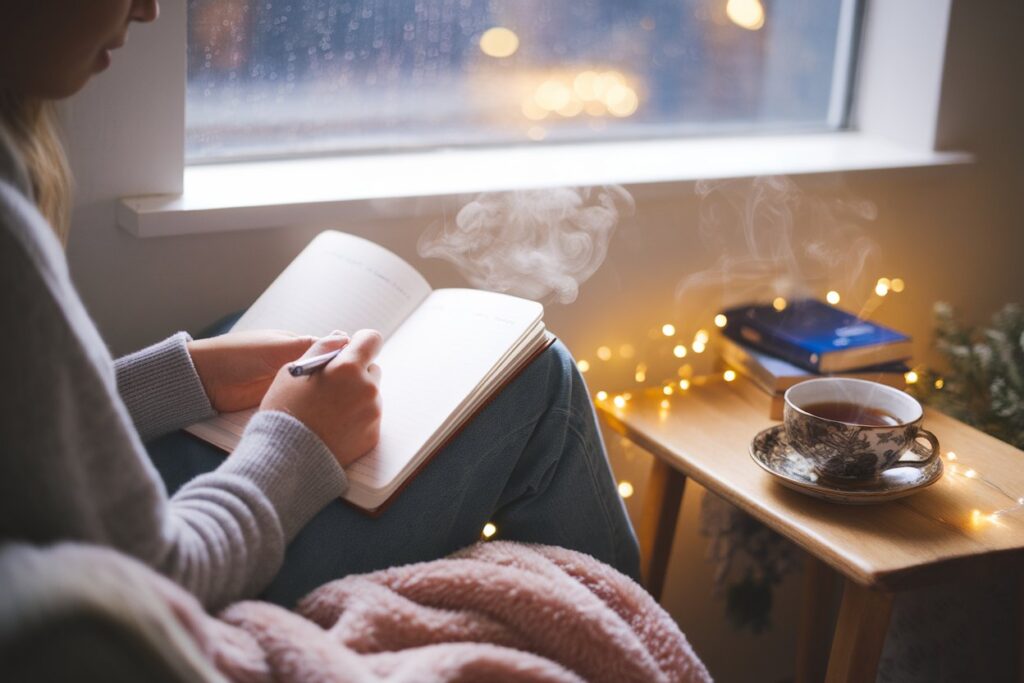
How Do I Choose the Perfect Spot for a Reading Nook in My Home?
Finding the right location for your reading nook is crucial for creating a space you’ll actually use. Here are some considerations when choosing the perfect spot:
Natural Light Sources
I always recommend positioning your reading nook near a window if possible. Natural light not only reduces eye strain but also creates a warm, inviting atmosphere that’s perfect for reading during daylight hours. A window seat can make for an ideal reading nook, combining seating and light in one perfect package.
Quiet Corners
Look for the quietest areas in your home. Consider the traffic patterns and identify spots that are naturally secluded from household activity. The corner of a bedroom, a landing on the stairs, or even an underutilized dining room corner can work wonderfully.
Space Requirements
You don’t need a large area to create an effective reading nook. A space as small as 3 feet by 3 feet can accommodate a comfortable chair and a small side table. The key is finding a spot that feels separate from the rest of your living space, even if it’s just a visual separation.
Consider Your Reading Habits
If you’re a morning reader, an east-facing window might be perfect. If you prefer reading in the evening, consider a spot with good artificial lighting options. Think about when and how you read most often, and choose a location that supports those habits.
I found my perfect spot in the corner of my living room, which gets beautiful afternoon light and is just far enough from the main seating area to feel like its own separate space.
What Are the Essential Elements of a Cozy Reading Nook?
Every reading nook needs certain key elements to make it functional and inviting. Here are the essentials:
Comfortable Seating
The foundation of any good reading nook is comfortable seating. This could be:
- A plush armchair with good back support
- A window seat with cushions
- A chaise lounge for stretching out
- A hanging chair for something unique
- A daybed for those who like to fully recline
I personally love a deep armchair that allows me to change positions frequently, as I tend to get fidgety during long reading sessions. The POÄNG chair ($149) is an affordable option that provides good support and comes in various colors to match your decor.
Proper Lighting
Good lighting is non-negotiable for a reading nook. Eye strain can quickly turn reading from pleasure to pain. Consider:
- Task lighting, like an adjustable reading lamp
- Ambient lighting such as string lights or a soft overhead light
- Natural light from nearby windows
Layer your lighting options so you can adjust them based on the time of day and your specific needs. The Lumii Lightbox ($89) offers customizable LED lighting that can be adjusted for different times of day and activities.
Writing Surface
Since your nook will serve double duty for journaling, you’ll need a surface for writing:
- A small side table at arm’s height
- A lap desk for flexibility
- A wall-mounted drop-leaf table if space is tight
- A rolling cart that can be pulled close when needed
I use a simple C-shaped side table that can slide over my chair arm when I need to write in my journal.
Book and Journal Storage
Keep your current reads and journals close at hand:
- Floating shelves on a nearby wall
- A small bookcase within reach
- Baskets for current reading materials
- Magazine holders for journals and notebooks
The West Elm Reclaimed Wood Bookshelf ($299) adds both storage and a rustic touch to your reading space.
Comfort Accessories
The final touches that make a reading nook truly cozy:
- Soft throw blankets
- Supportive cushions
- A small rug to define the space
- A footstool or ottoman
Don’t underestimate how important these seemingly small additions can be. The Threshold Performance Textured Throw Blanket ($24.99) is perfect for snuggling up with a book on cooler evenings.
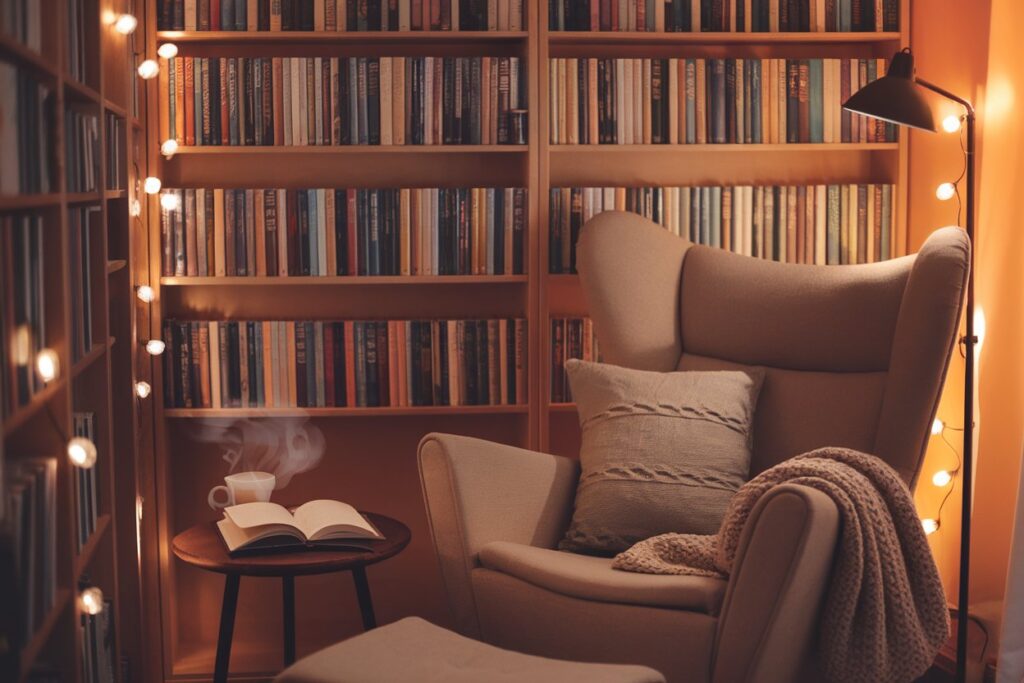
How Can I Incorporate Journaling Into My Reading Routine?
Combining reading and journaling creates a richer literary experience. Here’s how to seamlessly integrate journaling into your reading routine:
Select the Right Journal
Choose a journal that suits your reading journaling style:
- Structured Reading Journals: The Moleskine Reading Journal ($19.95) includes prompts for reviews and space for recording quotes.
- Blank Journals: The Leuchtturm 1917 EX LIBRIS Journal ($24.95) offers the freedom to create your own system.
- Bullet Journals: Perfect for those who want to track reading goals and create custom spreads.
- Digital Options: The Notion Reading Tracker Template allows for customizable databases for tracking your reads and reviews.
Create a Journaling Routine
Establish when you’ll journal about your reading:
- Before reading (to set intentions)
- During reading (to note immediate thoughts)
- After finishing each chapter
- Upon completing the book
I find that keeping my journal open while reading helps me jot down thoughts as they come, rather than trying to remember them later.
Journaling Prompts for Readers
Having prompts ready can help overcome writer’s block:
- What character do you most relate to and why?
- Write a letter to the author with your questions or thoughts
- How has this book changed your perspective?
- What quotes stood out to you, and why?
- If you could change the ending, what would you do differently?
Physical Setup
Your reading nook should facilitate easy transitions between reading and journaling:
- Keep writing tools within reach
- Use bookmarks with attached pens
- Consider a reading stand if you like to write while looking at the text
The Faber-Castell Pitt Artist Pen Set ($24.99) is ideal for journaling, with pens that don’t bleed through most journal pages.
What Types of Seating Are Best for a Reading Nook?
The right seating can make or break your reading experience. Here’s a breakdown of the different options:
| Seating Type | Best For | Pros | Cons | Price Range |
|---|---|---|---|---|
| Armchair | All-purpose reading | Supportive, comfortable | Takes up space | $150-$1000+ |
| Window Seat | Small spaces with windows | Space-efficient, natural light | Limited customization | $300-$1200 (DIY options available) |
| Chaise Lounge | Those who like to stretch out | Full body support | Requires more space | $200-$1500 |
| Floor Cushions | Casual readers, small spaces | Inexpensive, flexible | Less back support | $40-$200 |
| Hanging Chair | Unique spaces, younger readers | Fun, space-saving | Installation required | $100-$500 |
Your choice should reflect how you naturally read. I discovered that while a hammock looked appealing, I actually read better in a more upright position with good back support.
How Do I Add Storage for Books and Journals in My Reading Nook?
Effective storage keeps your reading materials organized and accessible:
Built-In Options
If you’re willing to invest in a more permanent solution:
- Window seat with storage drawers underneath
- Custom shelving built around your seating
- Wall-mounted cabinets above the nook
Freestanding Furniture
For more flexibility and lower investment:
- Small bookcase positioned within arm’s reach
- Rolling library cart that can be moved as needed
- Ladder shelves that take advantage of vertical space
- Floating shelves installed near your seating
Creative Solutions
For tight spaces or budget-conscious options:
- Repurposed crates stacked to create shelving
- Under-chair storage bins
- Over-the-arm caddy for current reads
- Wall-mounted magazine holders for journals
I use a combination of a small bookcase for my “to be read” pile and floating shelves for journals and reference books I reach for regularly.
What Lighting Options Are Ideal for Reading and Journaling?
Proper lighting prevents eye strain and creates the right atmosphere:
Task Lighting
Focused light for reading and writing:
- Adjustable floor lamps that can be positioned over your shoulder
- Clip-on book lights for nighttime reading
- Desk lamps with multiple brightness settings
Ambient Lighting
Creating a warm, inviting atmosphere:
- String lights draped around the nook
- Salt lamps for a warm glow
- Smart bulbs that can be adjusted via app
Natural Light Considerations
Maximizing daylight:
- Position your nook near a window if possible
- Use sheer curtains to diffuse harsh, direct sunlight
- Consider the direction your windows face when planning reading times
The combination of a good task light for reading and softer ambient lighting for atmosphere creates the perfect environment. String lights ($15-$30) create a magical atmosphere that makes reading feel like a special event.
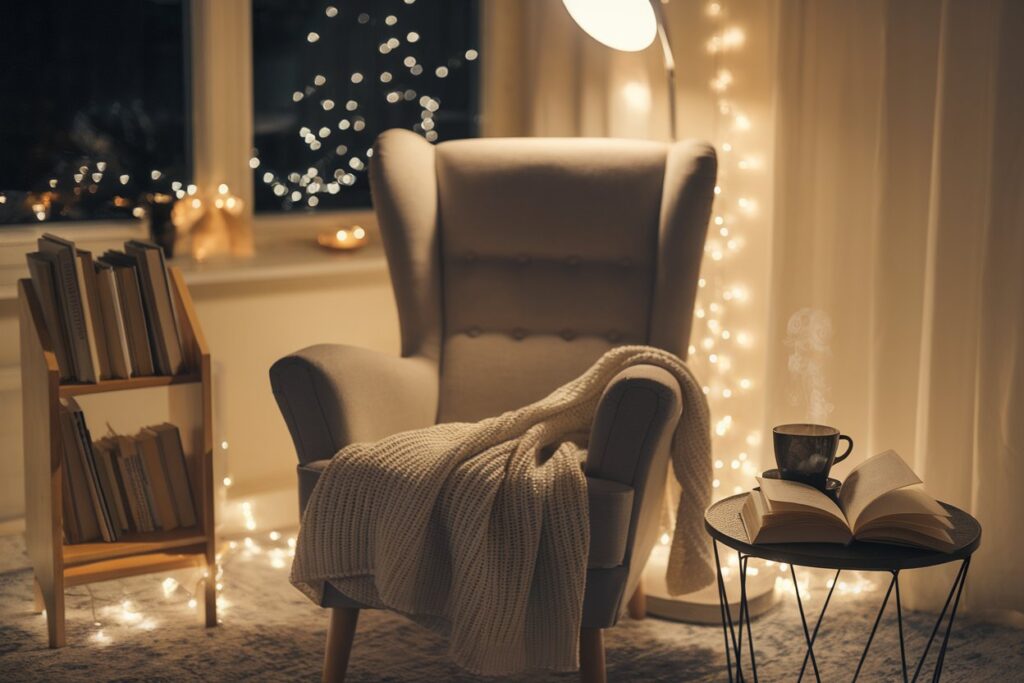
Can I Create a Reading Nook Outdoors?
Absolutely! Outdoor reading nooks offer a refreshing change of scenery:
Weather-Protected Spaces
Look for spots like:
- Covered porches or patios
- Garden arbors with overhead protection
- Balconies with awnings or umbrellas
Outdoor Furniture Considerations
Choose materials that can withstand the elements:
- Weather-resistant wicker or resin furniture
- Outdoor-rated cushions and fabrics
- Portable options that can be moved inside during bad weather
Seasonal Planning
Design your outdoor nook with year-round use in mind:
- Add a small heater for cooler months
- Include a fan for summer comfort
- Consider retractable awnings for sun protection
I created a simple outdoor reading nook on my small balcony using a weather-resistant chair, outdoor pillows, and a small side table. I added a large potted plant for privacy and shade, creating a little green retreat.
How Do I Style My Reading Nook with Textiles and Colors?
The right colors and textiles can transform your reading nook from basic to extraordinary.
Color Psychology
Different colors create different moods:
- Blues and greens promote calm and concentration
- Warm neutrals create a cozy, inviting feeling
- Brighter accents can energize the space
Choose colors that make you feel comfortable and match your reading goals. If you read to relax, cooler tones might be perfect. If you read to energize, warmer colors might work better.
Layering Textiles
Create depth and comfort through layering:
- Start with a small area rug to define the space
- Add seat cushions or chair covers in complementary fabrics
- Layer throw pillows in varying sizes and textures
- Finish with a soft throw blanket
The key is creating a sense of soft abundance without clutter. A faux fur rug ($40-$100) adds instant warmth and texture to any reading nook.
Pattern Mixing
Add visual interest through thoughtful pattern combinations:
- Start with a larger pattern for the main piece (like a chair)
- Add medium-scale patterns in complementary colors
- Finish with small-scale patterns or solids
The rule of three works well here: choose patterns in different scales but complementary colors for a cohesive look.
What Are Some Creative Ways to Repurpose Small Spaces into Reading Nooks?
You don’t need a dedicated room to create a reading nook. Here are some clever ways to repurpose small or underutilized spaces:
Under-Stair Nooks
The space under the stairs is often wasted but can make a perfect reading retreat:
- Add built-in bench seating with storage underneath
- Install small wall sconces for lighting
- Add cushions and pillows for comfort
Closet Conversions
Transform an underused closet into a cozy reading cubby:
- Remove the door and add a cushioned bench
- Install shelving above for books
- Add battery-operated lights if no wiring is available
- Hang a curtain for privacy when desired
Window Transformations
Turn any window into a reading nook:
- Add a bench seat below the window
- Include storage underneath for books and journals
- Add plenty of cushions for comfort
- Install a small shelf nearby for a cup of tea
Hallway Havens
Make use of wide hallways or landings:
- Place a narrow bookcase along the wall
- Add a small comfortable chair
- Use a wall-mounted reading light to save space
I converted an awkward alcove in my hallway into a reading nook by adding a custom cushion, some shelving, and a small pendant light. It’s now my favorite spot in the house!
How Can I Make My Reading Nook Feel More Intimate and Private?
Creating a sense of enclosure can make your reading nook feel like a true escape:
Visual Barriers
Define your space with:
- Room divider screens
- Hanging curtains from the ceiling
- Tall bookshelves positioned to create a corner
- Large plants that provide natural screening
Overhead Elements
Create a canopy effect with:
- Fabric draped from the ceiling
- A hanging pendant light positioned directly over the nook
- A small decorative awning or canopy frame
Audio Privacy
Reduce distractions with:
- A small white noise machine
- Noise-canceling headphones for reading music
- Acoustic panels disguised as art on nearby walls
Personal Touches
Make the space feel like it’s truly yours:
- Display meaningful objects that inspire you
- Include photos or artwork that makes you happy
- Add sensory elements like scented candles or essential oil diffusers
The Paddywax Library Candle collection ($24) offers book-themed scents that enhance the reading experience—imagine reading Thoreau while enjoying a forest-scented candle!
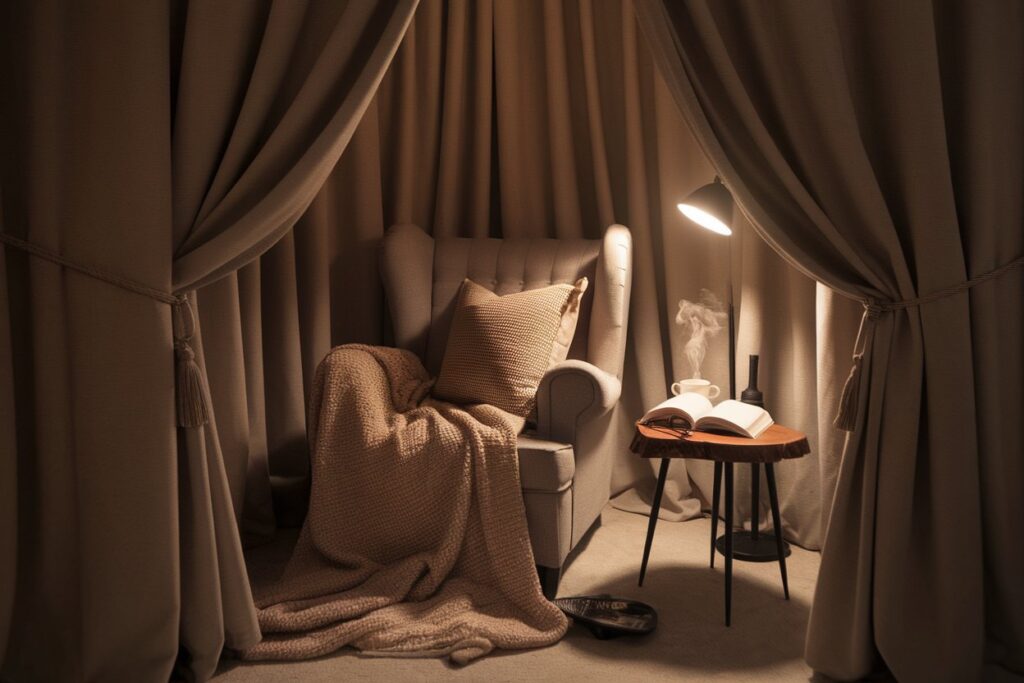
What Are the Benefits of Having a Dedicated Space for Reading and Journaling?
Creating a dedicated reading and journaling space offers numerous benefits beyond just having a comfortable place to sit:
Psychological Benefits
- Create a Ritual: Having a special place signals to your brain that it’s time to read and reflect
- Reduces Distractions: A dedicated space helps minimize interruptions
- Improves Focus: Regular use of the same space for reading trains your mind to concentrate more quickly
- Enhances Creativity: A personalized environment can inspire more creative thinking and journaling
Practical Benefits
- Organizes Reading Materials: Keeps books, journals, and supplies in one dedicated location
- Increases Reading Time: When reading is more accessible and comfortable, you’re likely to do more of it
- Improves Posture: A properly designed reading space supports good reading posture
- Protects Books: Designated storage helps preserve your book collection
Social Benefits
- Creates Boundaries: Family members learn to respect your reading time when you’re in your nook
- Models Reading Habits: Shows children the importance of making time for reading
- Offers a Meeting Place: Can become a spot for book clubs or sharing reading experiences
Having my own reading nook has increased my reading time by about 30% simply because it’s always ready and waiting for me, with everything I need within reach.
How Do I Incorporate Plants Into My Reading Nook Design?
Plants add life, color, and improved air quality to your reading space:
Best Plants for Reading Nooks
Choose plants based on your nook’s lighting conditions:
- Low-light options: Snake plants, pothos, ZZ plants
- Medium Light: Peace lilies, Chinese evergreens, prayer plants
- Bright Light: Fiddle leaf figs, rubber plants, and succulents
Strategic Placement
Position plants to enhance your nook:
- Tall floor plants can create natural privacy screens
- Hanging plants add visual interest without taking up floor space
- Small potted plants on shelves add color without cluttering
- Wall-mounted planters save valuable surface space
Plant Care Considerations
Be realistic about maintenance:
- Choose low-maintenance varieties if you’re not an experienced plant parent
- Group plants with similar watering needs
- Consider self-watering pots for convenience
- Remember that some plants are toxic to pets
I’ve found that having just two plants in my reading nook—a tall snake plant for privacy and a small pothos on my side table—adds life without creating maintenance stress.
What Are Some Popular Reading Nook Trends for 2024?
Stay current with these trending reading nook designs:
Natural Elements
Bringing the outdoors in is a major trend:
- Rattan and wicker furniture
- Natural wood finishes
- Stone accents
- Earth-tone color palettes
Multifunctional Spaces
Reading nooks that serve multiple purposes:
- Reading nooks that convert to Zoom call backgrounds
- Journaling spaces with built-in charging stations
- Reading areas that double as meditation corners
Technology Integration
Smart features for enhanced reading experiences:
- Built-in speakers for ambient sound
- Smart lighting that adjusts automatically
- Hidden charging stations for e-readers
Sustainability Focus
Eco-friendly reading nook elements:
- Upcycled and repurposed furniture
- Vintage and second-hand accessories
- Low-VOC paints and finishes
- Energy-efficient lighting
The trend I’m most excited about is the “invisible technology” movement—reading nooks that appear completely analog but have hidden smart features for convenience.
How Can I Use a Closet or Loft as a Reading Nook?
Transforming underutilized spaces can create magical reading retreats:
Closet Conversions
Step-by-step approach:
- Remove the door and clothing rod
- Add a comfortable bench seat or cushion that fits the width
- Install shelving above for books
- Add lighting (wall sconces, battery-operated lights, or a small lamp)
- Paint the interior a different color than the surrounding room
- Add cushions, pillows, and a small side table if space allows
Loft Transformations
Making use of vertical space:
- Ensure the loft area is structurally sound
- Add railings if needed for safety
- Create a comfortable seating area with floor cushions or a low chair
- Use wall-mounted or clip-on lighting solutions
- Include small shelves or baskets for book storage
- Add a rope ladder or spiral staircase for interesting access
Considerations for Small Spaces
Maximizing comfort in minimal square footage:
- Choose furniture that can be folded or moved when not in use
- Use vertical space for storage
- Select lighter colors to make the space feel larger
- Install mirrors to create the illusion of more space
- Use multi-purpose furniture (storage ottomans, folding desks)
I transformed my small walk-in closet into a reading nook by removing the clothes rack, adding a bench cushion, installing battery-operated lighting, and painting the walls a soothing blue. It’s now my favorite place to escape!
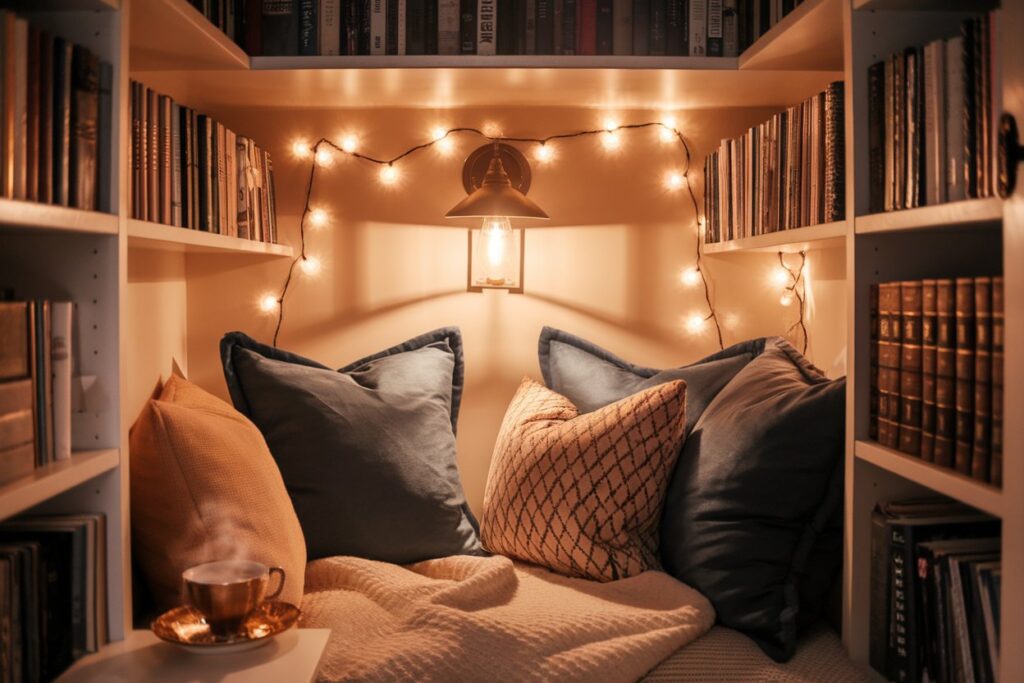
What Are the Best Types of Journals for a Reading Nook?
The right journal can enhance your reading experience and help you capture thoughts and insights:
Structured Reading Journals
Perfect for those who want guidance:
- Leuchtturm 1917 EX LIBRIS Journal ($24.95): Includes sections for tracking books and writing reviews
- Moleskine Reading Journal ($19.95): Features prompts for reviews and quotes
- Book Lover’s Journal: Includes sections for ratings, reviews, and reading lists
Blank Journals
For those who prefer freedom and flexibility:
- Rhodia Reverse Book ($18.95): Spiral-bound for easy note-taking
- Archer & Olive Journals: Features thick pages for those who use various media
- Traveler’s Notebook: Customizable with different inserts for different purposes
Digital Options
For the tech-savvy reader:
- Notion Reading Tracker Template: Customizable database for tracking reads
- Kindle Scribe ($339.99): Allows for annotations directly on e-books
- GoodReads App: Syncs with physical journals for yearly reading goals
Specialty Journals
For specific reading journaling styles:
- Q&A a Day for Book Lovers: Five-year journal with daily literary questions
- Bookworm Journal: Includes space for illustrations and reactions
- Reading Time Journal: Focuses on tracking time spent reading
I personally use a combination of a Leuchtturm 1917 for structured book tracking and a blank journal for more in-depth reflections on what I’m reading.
How Do I Keep My Reading Nook Organized and Clutter-Free?
An organized reading nook enhances both comfort and functionality:
Smart Storage Solutions
Keeping books and accessories in order:
- Implement a one-in, one-out policy for books
- Use vertical storage to maximize space
- Sort books by current reading status (to-read, currently reading, reference)
- Store journals by date or project for easy access
Daily Maintenance
Simple habits to keep your nook tidy:
- Return books and journals to their designated spots after use
- Keep a small basket for miscellaneous items
- Have a dedicated spot for reading glasses, bookmarks, and pens
- Take drinks and snack containers back to the kitchen immediately
Seasonal Refresh
Deeper organization on a regular schedule:
- Reassess your book collection quarterly
- Rotate seasonal textiles (lighter throws in summer, heavier in winter)
- Deep-clean cushions and upholstery
- Update journal storage as completed journals accumulate
Washi tape sets ($12-$20) are perfect for organizing journals by theme or date, adding a decorative touch while keeping things functional.
Can I Use a Reading Nook for Other Activities Besides Reading and Journaling?
Absolutely! A well-designed reading nook can serve multiple purposes:
Meditation and Mindfulness
The quiet, comfortable space is perfect for:
- Morning meditation sessions
- Mindfulness practices
- Breathing exercises
- Gentle stretching or yoga
Creative Pursuits
Your nook can double as a creative space for:
- Sketching and drawing
- Letter writing
- Poetry composition
- Photography planning
Professional Activities
With minor adjustments, your nook can work for:
- Virtual meetings (with a neutral background)
- Podcast recording (if acoustics are good)
- Professional development reading
- Online courses and webinars
Social Connections
Share your reading space for:
- One-on-one conversations
- Small book club meetings
- Reading aloud to children
- Literary-themed gatherings
I’ve found that my reading nook makes an excellent meditation space in the early mornings, while in the evenings, it transforms back into my reading retreat.
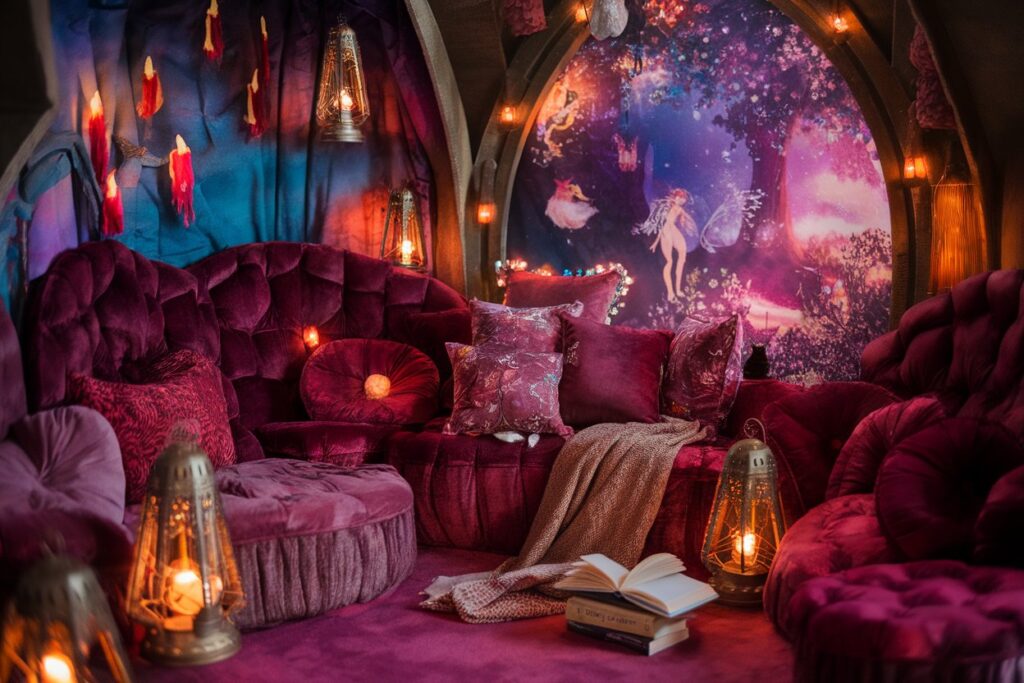
How Do I Create a Themed Reading Nook?
A themed reading nook can reflect your personality and reading preferences:
Literary-Inspired Themes
Based on favorite genres or authors:
- Classic Library: Leather-bound books, dark woods, vintage accessories
- Sci-Fi Sanctuary: Modern furniture, LED lighting, metallic accents
- Poetry Corner: Natural materials, soft lighting, artwork featuring favorite quotes
- Mystery Den: Rich colors, atmospheric lighting, vintage detective elements
Design Style Themes
Based on interior design preferences:
- Mid-Century Modern: Clean lines, classic furniture pieces, bold geometric patterns
- Bohemian Retreat: Layered textiles, floor cushions, global-inspired accessories
- Minimalist Haven: Neutral colors, hidden storage, multi-functional furniture
- Rustic Cabin: Natural woods, plaid textiles, vintage accessories
Special Interest Themes
Based on personal hobbies or passions:
- Travel-Inspired: Maps, global souvenirs, books organized by country
- Nature Lover’s Nook: Plants, natural materials, landscape photography
- Vintage Book Collector: Display of first editions, typography art, classic bookends
- Literary Cafe: Coffee station, bakery-inspired scents, cafe-style seating
My own reading nook has a subtle “English cottage library” theme, with floral patterns, vintage botanical prints, and a collection of British classics displayed prominently.
What Are Some DIY Projects for Building a Reading Nook?
Create a custom reading space with these approachable DIY projects:
Weekend Projects
Accomplish these in 1-2 days:
- Floating Bookshelves: Mount simple wooden shelves using brackets or invisible brackets
- No-Sew Window Seat Cushion: Use foam, fabric, and fabric glue to create a custom cushion
- Reading Nook Canopy: Hang fabric from a ceiling-mounted curtain rod for an enclosed feel
Beginner-Friendly Builds
For those with basic tools and skills:
- Window Seat with Storage: Convert a window area with pre-made cabinets and a custom top
- Reading Nook Divider Screen: Create a folding screen with wooden frames and fabric panels
- Book Nook Side Table: Repurpose a wooden crate with added wheels and a finished top
Advanced DIY Projects
For experienced DIYers:
- Built-In Reading Alcove: Frame out and finish a recessed area with custom shelving
- Reading Loft Platform: Construct an elevated reading platform in an unused corner
- Closet-to-Reading Nook Conversion: Fully transform a closet with built-in seating and lighting
I created a simple but effective reading nook corner by installing floating shelves in a corner, positioning a comfortable chair beneath them, and adding a small side table made from a wooden crate. The entire project cost under $200 and took just one weekend.
The Joy of Having Your Own Reading and Journaling Sanctuary
Creating a dedicated space for reading and journaling isn’t just about having a comfortable spot to sit—it’s about honoring your relationship with books and your own thoughts. In our busy digital world, having a physical space dedicated to the analog pleasures of reading and writing by hand can be revolutionary.
Your reading nook becomes more than just furniture; it becomes a visual reminder to make time for reading, reflection, and self-discovery. It stands as a testament to the value you place on literature and your own thoughts.
Whether you create an elaborate window seat filled with cushions and surrounded by bookshelves or simply carve out a quiet corner with a comfortable chair and good lamp, the important thing is making the space your own. The perfect reading nook reflects your personality, supports your reading habits, and invites you to sit down, open a book, and let the rest of the world fade away for a while.
So gather your favorite books, find your perfect journal, and create the reading sanctuary you deserve. Your future self—curled up with a great book and a fresh page in your journal—will thank you.
